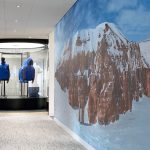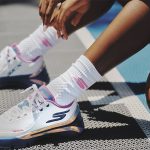Integrated ski systems helped the alpine ski equipment category this season with admirable gains in both specialty and chain stores. In the specialty stores, all integrated ski system sales were up 25% in dollars through February, prompted by average retail prices which were $78 cheaper than last season. By the end of February 2004, integrated ski systems were 70% sold-through and totaled $58.7 million in sales. Overall, integrated ski systems have been strong performers this season with sales beating last seasons sales by an average of 23% each month.
Even with the success of integrated ski systems, overall equipment sales (alpine, snowboard, Nordic and telemark) were down 3% in dollars as compared to last season with sales totaling $604.7 million through February 2004. For the fifth straight month this season, equipment sales are tracking behind as compared to last seasons sales. Alpine equipment (including skis, boots, bindings, poles and systems) contributed to the decline this period, tracking 13% behind in dollar sales this season over last.
Alpine skis, excluding integrated systems, fell 20% in dollars over last season, ending February 2004 with $114.1 million in sales. Even the lower retail prices (down 10%) did not spur sales. Substantial dollar decreases came from carve skis (down 37% to $13.5 million), ski boards (down 34% to $3.2 million) and midfat skis (down 27% to $61.5 million). Through February, 39,000 carve skis were sold, down from 63,000 last season. In contrast, carve ski dollar sales are growing in chain stores prompted by a $72 jump in average retail price this season over last.
Retailers found a new niche this season. Fat ski sales managed a healthy jump of 24% in dollars over last season ending February with $7.6 million in sales. “Fatter under the foot” continues to be the present trend. The season-to-date retail price of $520 is $30 cheaper than last seasons price.
Carryover ski sales rose 23% in dollars to $10.5 million. One out of every 7.4 pairs of alpine skis sold (excluding systems) was a carryover unit.
CONSUMERS PURCHASING JUNIOR SKI EQUIPMENT
Junior ski equipment provided some hope for the alpine ski equipment category in February. Although lower prices kept dollar gains low, unit increases were considerable for most junior ski equipment categories. Junior skis, boots and bindings experienced unit increases over last season, 22%, 29% and 21%, respectively. Junior poles did not fare as well with a 1% unit gain over last season.
Although junior boot sales increased, overall alpine boot sales still declined. Alpine boot sales declined
14% in dollars due to falling sales in recreation boots (down 40% to $14 million), soft boots (down 29% to $8.7 million) and high performance boots (down 18% to $56.5 million). Soft boots continued their decline as average retail prices plunged from $326 to $260 in February, a 20% drop. In line with their ski sales, carryoverboots also continued to track well this season with a 10% increase over last season.
Along with a drop in alpine ski and boot sales, came a drop in alpine binding sales as compared to last season overall down 26% in dollars to $41.7 million through February 2004. Contributing to this drop were falling sales in DIN 1-7bindings (down 79% to $3.3 million), DIN 8-11 bindings (down 26% to $20.1 million), DIN 12-14 bindings (down 37% to $12.2 million), skiboard bindings (down 79% to $24.6 million) and carryover bindings (down 24% to $2.1 million).
Poles did not keep pace with total ski sales. Alpine pole sales declined totaling $11.6 million through February 2004. The entire alpine pole category fell 17% in dollars, largely due to a 44% plunge in carryover pole sales over last season.
GROWING INTEREST IN TELEMARK EVIDENT
Nordic and telemark ski equipment continue to gain popularity in specialty stores. Nordic ski equipment sales jumped 42% in dollars to $35.6 million through February 2004. Nordic skis (up 46% to $14.8 million), boots (up 39% to $11.8 million), bindings (up 46% to $5.6 million) and poles (up 31% to $3.4 million) are growing in popularity at the same pace. Comparing this season to last, average retail prices of Nordic skis increased $16 to $135.
Telemark ski equipment sales performed even better, culminating in a 74% increase over last seasons sales and reaching $6.4 million through February 2004. Although average retail price decreased $24 to $344 through February, telemark ski sales increased 37% in dollars. Telemark boot and binding sales leapt 93% and 110%, respectively. With boot and binding sales outpacing ski sales, telemark skiers seem to be retrofitting old alpine skis or are updating their old telemark skis with new bindings.
Combined, Nordic and telemark sales totaled $42 million this season, compared to alpine equipments $365.5 million in sales.
CARRYOVER DRIVING SNOWBOARD EQUIPMENT MARKET
Along with Nordic and telemark equipment, snowboard equipment (including snowboards, boots and bindings) is also tracking ahead of last season in dollars at specialty stores. Through February, all snowboard equipment sales were up 15% in dollars ending with $197.2 million for the season thus far. (In chain stores, snowboard equipment sales were down 4% through February).
Snowboard (up 15% to $91.6 million), boot (up 14% to $58.8 million) and binding (up 17% to $46.8 million) sales all increased at similar paces this season over last. All mountain (up 48% to $7.7 million) and carryoversnowboard (up 53% to $7.1 million) sales performed remarkably well as compared to last season. All mountain boards, which represent 8% of the snowboard dollars sold this season, maintained an average retail price of $234 through February, down from $240 last season. Freestyle boards continued to gain popularity with sales reaching $36.6 million through February 2004. These boards accounted for 40% of the dollars thus far this season. Freeride board sales were flat as compared to last season.
Carryover boots and bindings continue to perform well for the snowboard equipment market this season, up 70% and 111%, respectively, over last season. Step-in boots and step-in bindings are experiencing the opposite results this season with 76% and 65% drops in dollar sales, respectively, over last season.
SNOWSHOES MAINTAIN A FOLLOWING
Although accessory sales were up 9% in chain stores, the accessories category in specialty stores was down 1% in dollars to $521.4 million through February 2004. Equipment accessories, in particular, declined 10% due to substantial drops in snow deck/skate and helmet sales, 53% and 28%, respectively. Snowshoes cushioned these declines with a healthy jump of 22% over last season up to $16 million through February 2004. Sunglasses, auto racks and goggles each declined 4%, respectively.
Apparel accessory growth slowed down in February with sales up 8% in dollars to $291.9 million over last season. Winter boots (up 65% to $13.9 million), gloves (up 17% to $50.3 million), base layer (up 15% to $71.7 million) and socks (up 14% to $31.6 million) all experienced moderate increases over last season. Turtleneck and headgear sales in dollars continued to track behind in February, declining 23% and 10%, respectively, over last season.
APPAREL BENEFITS FROM EAST COAST TEMPERATURES
For the month of February, s pecialty apparel sales (including tops, bottoms and snowboard) were up 9% in dollars to $82.8 million as compared to $73.7 million in February 2003. Insulated parkas, soft shells and snowboard apparel continued to perform exceptionally well this season in part due to the cold weather on the East Coast. When comparing this season to last, insulated parka sales were up 20% to $109.2 million. Women propelled insulated parka sales up 27% in dollars over last season.
Soft shell parkas have doubled their sales over last season. At an average retail price of $202 in February, they were up a substantial 104% in dollars to $12.6 million. Soft shell waist pants performed almost as well as their parka counterparts, jumping 92% in dollars over last season to $1.8 million. The brutal weather also helped contribute to very good fleece and base layer apparel sales. As compared to last season, fleece tops were up 26% to $58 million and base layer apparel up 15% to $71.7 million.
By the end of February, all snowboard apparel was up a considerable 17% in dollars to $91.2 million in sales for the season thus far. In particular, junior snowboard tops and womens snowboard bottoms continued to see increased sales over last season, gaining 25% and 22%, respectively. The average retail price for all snowboard bottoms fell $7 from last season to $102. Carryover snowboard apparel continues to be very popular with riders this season. Sales almost doubled this season, up 73% in dollars to $7.3 million through February 2004.
Shell parkas and apparel suits did not fare so well, with dollar sales falling behind 10% and 39%, respectively, over last season. Vests (no fleece) (down 4% to $3.5 million) and sweaters (down 16% to $19.7 million) also tracked behind last seasons sales. While most apparel suits are tracking behind last seasons sales, stretch suit sales were up 17% over last season.
SALES FLAT FOR SPECIALTY STORES
Overall sales at specialty stores were up 1% in dollars to $1.61 billion for August 2003 through February 2004 as compared to $1.59 billion for the same period last season. “Strong performers in the specialty stores this period included integrated ski systems, snowboard equipment and alpine and snowboard apparel,” said Christine Martinez, market research manager for SnowSports Industries America (SIA), the not-for-profit industry trade group that represents manufacturers and distributors of snow sports products. Unit sales at specialty stores were up from last season tracking 4.8% ahead. Sales for the month of February in specialty stores were $266.5 million compared to $273 million in February 2003, a decrease of 2.4%. Unit sales dropped for the month by 1.5%.
Overall sales for the entire winter sport market (including specialty and chain stores), increased slightly by 1.4% in dollars to $2.06 billion for August 2003 through February 2004 as compared to $2.03 billion for the same period last season according to the SIA Retail Audit. Unit sales were ahead 4.6%. The SIA Retail Audit tracks and reports sales in all snow sports product categories. This is the fifth report of six that look at sales through March 31, 2004, the end of the winter season.














